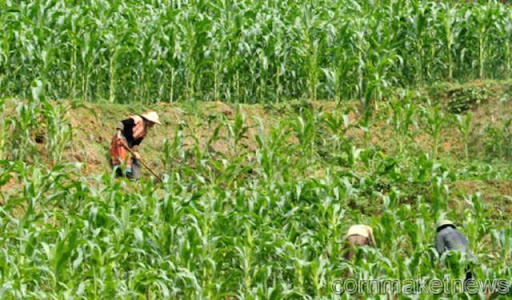Friday, March 4, 2011
Deere, Ukraine Mobilize as World Corn Supplies Hit 37-Year Low
 The agricultural price rally of 2008 unleashed riots in more than 30 countries and forced companies into bankruptcy. It lasted five months.
The agricultural price rally of 2008 unleashed riots in more than 30 countries and forced companies into bankruptcy. It lasted five months.
The latest rise in commodity prices, which has already helped topple regimes in Tunisia andEgypt, may last many more months, if not years.
“If you are not scared, you are not paying attention,” says David Nelson, a global strategist in the food and agribusiness research advisory unit of Rabobank in Chicago. “There is no margin for error with these agricultural markets.”
That prospect has governments and companies around the world searching for ways to profit or insulate themselves from price shocks, Bloomberg Businessweek reports in its March 7 issue. A growing, more prosperous global population is draining stores of grain and meat.
Global inventories of corn -- used in food, feed and fuel -- will fall to just 53 days, a 37-year low, before harvests in the northern hemisphere begins, according to U.S. Department of Agriculture data. Soybean stockpiles worldwide as a percent of demand may be the lowest in almost 18 years, Paris-based Societe Generale forecast last month.
Tight inventories and a recovering global economy set this rally apart from the abrupt rise and fall in 2008. That’s when crude oil led commodities higher in February, and a plunge in food demand amid the recession pulled prices back down in July.
‘This is Sustainable’
“This one is different,” says Dennis Gartman, an economist and editor of The Gartman Letter, a market tracker. “This is sustainable. We’re coming out of global recession, and we’re going into global strength.”
Deere & Co. (DE), the world’s largest farm-equipment maker, is building factories in emerging markets such as Russia and India to capitalize on this growing appetite.
“Between now and 2050, food output is going to have to double,” Chief Executive OfficerSamuel Allen said in a telephone interview.
The Moline, Illinois-based company in January announced a $100 million investment in India to build a new factory and expand an existing tractor plant. Deere is marketing a 36- horsepower tractor for smaller Indian farms rather than the 300- horsepower models popular on larger farms in the U.S. It also has partnered with the Gujarat state government to set up an equipment-sharing program for small tribal growers.
Ox to Tractor
“A farmer on one hectare of land could never afford that tractor,” Allen says. “If you help them mechanize, that helps them go from using an ox to a tractor. They will be able to triple farm income because they will significantly increase production.”
The company also opened a factory and distribution center in Russia last year that will make equipment including tractors.
“It has to become more of a bread basket to feed the world,” says Allen, noting that Russia has 9 percent of the world’s arable land.
Other companies are lobbying Washington to boost the number of U.S. acres that can be farmed. The Andersons Inc. (ANDE), a Maumee, Ohio-based grain merchandiser and elevator operator, is calling for the temporary removal of some of the 31.2 million acres (12.6 million hectares) set aside by the federal Conservation Reserve Program. The CRP pays farmers to leave land idle as a way of preventing soil erosion and other environmental damage.
“We need to have large enough crops where we can stop the decline and start to replenish,” says Hal Reed, president of Andersons’ grain and ethanol group and chairman of the Washington-based National Grain and Feed Association. “To do that, there aren’t enough acres to be planted.”
Koreans Scout Chicago
Governments are finding new ways to secure supplies and temper prices. South Korea, where prices of food and nonalcoholic drinks climbed to at least a 10-year high of 14.1 percent in October, is setting up a trading firm in Chicago to buy grain. It’s one of the steps the country, which soon will be importing nearly all of its corn, is taking to secure food at a reasonable price.
The state-run Korea Agro-Fisheries Trade Corp. will team with private companies to establish the firm with the goal of handling about 30 percent of South Korea’s annual imports by 2020.
To tame food prices after drought damaged crops last year, Ukraine has started to work with Leo Melamed, the chairman emeritus of Chicago-based CME Group Inc. (CME), to develop its own wheat futures market. An exchange would damp price surges, since farmers could use it as a hedge to reduce losses when crops fail, giving them confidence to plant more in seasons to come, says Melamed, who introduced currency futures in 1972.
Peaks and Valleys
“Over the long run, it smoothes out peaks and valleys,” he says.
Companies that buy grains also are preparing themselves for higher, more volatile prices.
Sanderson Farms Inc. (SAFM), the fourth-largest U.S. chicken producer, in February said it would delay plans to build a new processing plant in North Carolina until there is “some visibility” regarding crop prices in 2011. In the Laurel, Mississippi-based company’s first fiscal quarter, feed -- made up of corn and soybean meal -- accounted for 52 percent of the cost of producing chicken.
Meat processors want to avoid the fate of Pilgrim’s Pride Corp., which was pushed intobankruptcy protection in 2008, partly by high feed costs. Corn and soybean futures traded in Chicago rose 52 percent and 34 percent, respectively, in 2010.
“There may be gyrations, wild gyrations, this spring and summer during the planting season, if it’s wet or dry,” says Sanderson CEO Joe F. Sanderson Jr. “It could just be explosive.”

This post was written by: HaMienHoang (admin)
Click on PayPal buttons below to donate money to HaMienHoang:
Follow HaMienHoang on Twitter













0 Responses to “Deere, Ukraine Mobilize as World Corn Supplies Hit 37-Year Low”
Post a Comment